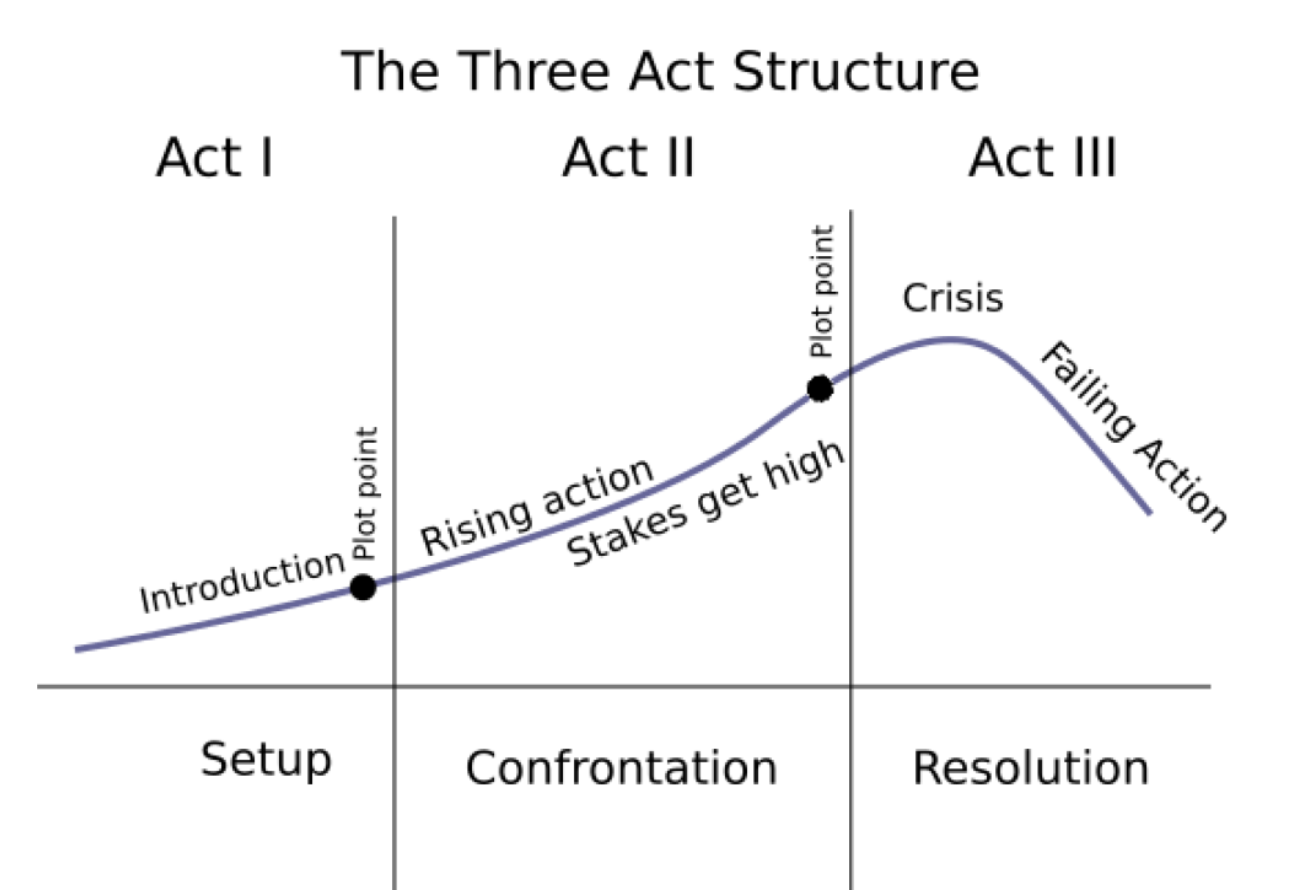How to Use the Three Act Structure To Write Your Messy First Draft

For writers working in narrative, there’s nothing quite as anxiety-provoking as the question of whether or not we have the structure right.
We work for months on our messy first draft, some of us for YEARS even, hoping with our fingers crossed that when we get to the end, we’ll have a story that basically works and won’t have to be completely rewritten from scratch because we didn’t get the fundamentals right.
The trick is in how to do that exactly…
There are many options for structuring a story – and likely some that have yet to be invented – but in this blog post, I’m going to clarify the classic 3 act structure and hopefully demonstrate how you can use it as a tool to help you shape your messy first draft so that you end up with a book that works at its most basic level.
This structure is classic like a Chanel suit because it’s that well-constructed and can take you anywhere, and it’s also classic as in Seen on TV, literally. Most of your favorite TV shows rely on a simple 3-Act structure.
The Three Act Structure: Origins
Aristotle gets the credit for this – going all the way back to 384 BCE. We say this structure is Aristotelian (try saying that 3 times fast!) because it was Aristotle (in Poetics) who declared that a “whole story” has a Beginning, Middle and End.
He was referring to the great Greek tragedies, where the End means you’ve just killed your mother or husband, but still…the concept holds.
This structure is so commonly spoken of that we are in danger of glossing over it and thinking it’s too basic to be interesting for modern writers.
The Three Act Structure: Beginning, Middle and End
What’s most helpful about the three act structure is that it provides a sense of closure and satisfaction to a story. The human brain loves an open story loop, but once it is opened up for us a part of our brain is always on the lookout for how this thing is going to end.
We can think of it as a simple set of 3 basic elements, but it goes beyond that…the Three Act Structure is almost fractal in nature. (A fractal is a never-ending repeating pattern; they look similar at different scales.)
- The whole story has a Beginning, Middle and End.
- Each scene has a Beginning, Middle and End.
- Chapters have a Beginning, Middle and End.
- Sub-plots have a Beginning, Middle and End.
It’s like a pebble dropped in a pond – there’s an inherent structure WITHIN the structure.
Books written in the classic Three Act Structure (and that’s MOST books) have a sense of unity about them that’s engendered by this structure, and this unity provides a sense of satisfaction for the reader as everything ties together.
But Freytag Though
And if you’re reading this and wondering “what about Rising and Falling Action?” then you might be confusing Aristotle with Gustag Freytag and his pyramid, which might feel familiar from high school English Lit classes. For today, we’ll stick with our boy Aristotle.
The Three Act Structure: Movement within Movements
Later elaborations of the Three Act Structure divide it as follows;
- Beginning – Setup
- Middle – Confrontation
- Ending – Resolution
In this visualization below, which is how the Three Act Structure is typically represented, Aristotle’s basic structure has Freytag’s notion of rising and falling action mapped onto it.

Act One: Beginning : Setup
The role of Act One is to introduce us to the story. We meet our protagonist, the main character around whom the story will revolve. We get to know their world and how they’re currently living, thinking and feeling about their life.
Act One is also where the story problem is setup – this is the external problem that the story will revolve around and the protagonist will have to face. We also learn about the internal problem faced by the protagonist, the inner conflict s/he/they will have to resolve as they deal with the external problem.
At the end of Act One, the protagonist makes a choice to move forward, to engage more deeply with the central story problem, and this is a choice that s/he/they can’t easily go back on. It’s the choice that will govern everything that comes next.
Knowing this moment of choice is critical…it will save you from the dread realization at the end of a completed draft that you have written a passive protagonist – someone to whom everything seems to happen, a character without personal agency. In short, a dead boring character the reader can’t bear to spend time with. This moment at the end of Act One is the threshold into Act Two and as a writer, it can save your book.
Act Two: Middle : Confrontation
I actually prefer the term Complication for Act Two. This is where sh*t gets real for our protagonist and it’s clear that a return to the status quo isn’t possible. It’s where the protagonist confronts obstacles on her way to resolving the central story problem, where the stakes – why it matters that she DOES resolve the story problem – become clear and increasingly important and/or urgent.
If you prefer the idea of Complication for Act Two, you might enjoy Save the Cat Writes a Novel by Jessica Brody, which takes what was originally a screenwriting framework and applies it to novel-writing. In a Save the Cat structure, Act Two involves “Fun and Games” and these are set out via beats.
In any case, Act Two is where obstacles must be faced. Smaller obstacles might be overcome en route to a final confrontation that is the ultimate obstacle for our protagonist. Which leads us to…
Act Three: Ending: Resolution
The beginning of Act Three is a crisis point, the most important crisis of the story. Here is where our protagonist faces the final test and must resolve the central story problem one way or another.
Girl and her romantic interest finally end up together? Romance problem resolved. Murderer unveiled? Crime problem resolved. Woman comes to terms with her relationship with her mother in some important way? Literary problem resolved. That’s all rather simplified, but you get the idea.
Using the Three Act Structure To Write A Messy First Draft
I’m not a plotter by nature – I prefer to intuit my way into my story, at least in my early drafts. However, I have done a simple plot by mapping out key plot points on the Three Act Structure. In this way I can be sure of two things:
- I will have a Beginning, Middle and End to my story and therefore write a story that my reader will intrinsically find satisfying.
- I won’t write a draft with a passive protagonist, where everything happens to them but they have no personal agency. Boring character – and therefore boring story – averted!
Try it out…sketch out your story against the Three Act Structure diagram above and see how it looks:
- Do you have a clear moment that illuminates your protagonist’s choice to move out of the status quo at the end of Act One?
- Do you have rising action (and rising stakes that matter) in Act Two?
- Do you have a Crisis moment to start off Act Three?
- Do you resolve all the important threads of your story at the end of Act Three?
And one final check in the revision stage using the Three Act Structure:
- Can you identify your Beginning, Middle and Ending?
- For the Story overall, for each Act, for each Chapter, for each Subplot?
You can see how the basic Three Act Structure is not so basic after all and how simple it can be to use this classic framework to help you write a story that works, even in the messy first draft stage.

